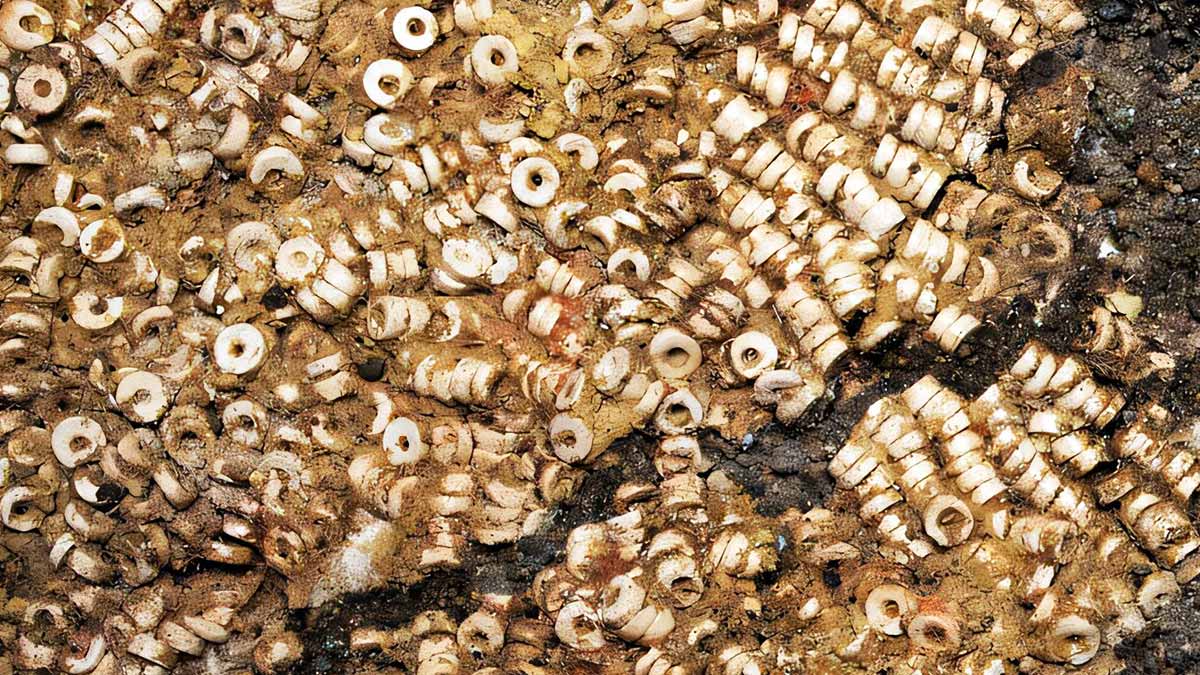Shimmering clothing once spoke louder than words, and this ancient tomb proves it. Inside a vaulted chamber, shell discs formed tunics, skirts, and veils that flashed as their owners moved. The beadwork, dense and bright, signaled wealth, labor, and belief. What survives now is scale: hundreds of thousands of polished pieces, arranged with care, hinting at leaders who turned craft into power without leaving a written line.
Beads, labor, and status inside the ancient tomb
Beneath Valencina de la Concepción in southwestern Spain stands the Montelirio tholos, a Copper Age burial used between 2875 BCE and 2635 BCE. One chamber, 328 feet from the celebrated “Ivory Lady,” held twenty people. Fifteen were identified as women. Archaeologists cataloged bones, garments, and adornments, then counted over 270,000 beads, each under a third of an inch. Many still reflect light, so garments once sparkled white and green beside cinnabar, amber, and ivory.
Most discs were cut from Atlantic scallop shells, Pecten maximus, collected only a few miles away. Seven researchers needed 651 work hours just to separate beads from soil. The count alone points to planning, storage, and skilled hands. A community that feeds farmers and specialists at once can also fund ritual. That is what this chamber shows with clarity and grace inside an ancient tomb raised for memory and display.
Craft measured the effort. Experimental replicas set ten minutes to shape and drill one disc. Ten artisans, on eight-hour shifts, would need 206 straight days to equal the trove found here. Before cutting, people hauled nearly 2,200 pounds of raw shell inland. Food had to cover workers; organizers had to manage deliveries; leaders had to decide that gleaming attire justified the cost. Beads made hierarchy visible and audible.
How the system worked, and why time mattered
Microscopic fibers show the discs were sewn to a woven base, likely linen. Replica garments proved heavy, stiff, and loud. Daily wear made little sense, so the outfits probably appeared during ceremonies. Two hundred pounds of clacking attire turned a body into a moving billboard. Whoever wore that weight controlled labor, resources, and attention, and did so through sound, shine, and motion inside a crowded room.
Radiocarbon dates cluster tightly for beads and bones, so makers likely finished garments near burial time. One outlier bead looked younger than the skeleton beside it. Two readings follow from that mismatch. The tomb may have reopened over about thirty years, with new clothes made for each rite. Or a sudden crisis claimed many lives, and craftswomen sprinted for seven months before a collective interment in the same stone room.
Both options demand order. Calendars must align; supplies must arrive; hands must work with pace and care. The scale at Montelirio echoes wider Copper Age projects in Iberia. Irrigated plots grew emmer wheat; trade routes carried ivory over long distances. The beadwork fits that world. It links field, sea, and shrine while it turns surplus into spectacle within a carefully managed ancient tomb where symbols mattered.
What the ancient tomb reveals about power and belief
Placement marked rank. Two women, labeled UE343 and UE102, rested near a small altar by the entrance. Their beadwork was the most elaborate, and both were older than most others, mid-twenties to early thirties. One lay face-down, an unusual pose that may signal a special spiritual role. These clues suggest seasoned female leaders controlled resources, mastered ritual, and stood at the center of public display.
Shell beads often serve as currency or status markers elsewhere. Chumash communities in California moved them across hundreds of miles. In medieval Europe, jet and amber signaled rank. Valencina producers standardized disc size and color, which hints at a medium of exchange that high-status households could commission, then redistribute. By stitching value to clothing, wealth sat on the skin and walked with its owner.
Seashells also bridge worlds. Atlantic shells tied inland villagers to tides and maritime trade. Later Mediterranean cultures linked scallop imagery to love and birth. Montelirio predates those myths by two thousand years, yet the themes still resonate. Ordinary materials gain symbolic reach when many hands polish, drill, and thread them. With fifteen women in this chamber, plus the “Ivory Lady” nearby, leadership was not strictly male inside this ancient tomb.
Why these shell garments still reshape how we see prehistory
Numbers tell the story as much as shine. Hundreds of thousands of discs, 651 catalog hours, ten minutes per bead, 206 workdays, and 2,200 pounds of shell add up to organized power. They show surplus, planning, and ceremony woven together. Through light, sound, and weight, garments turned belief into action. Because the message still reads, the ancient tomb keeps teaching, and the past keeps speaking in polished shell.
